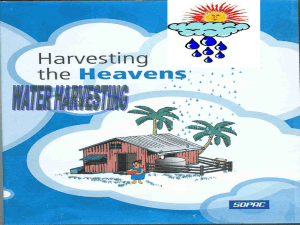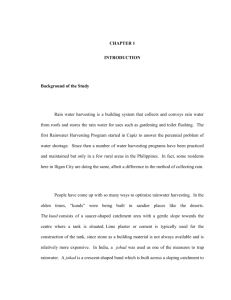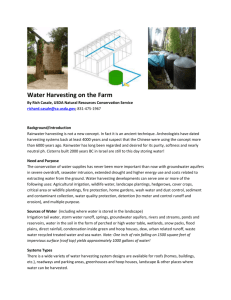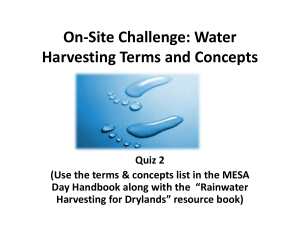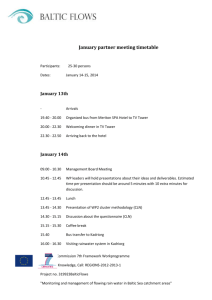Word - UNEP
advertisement
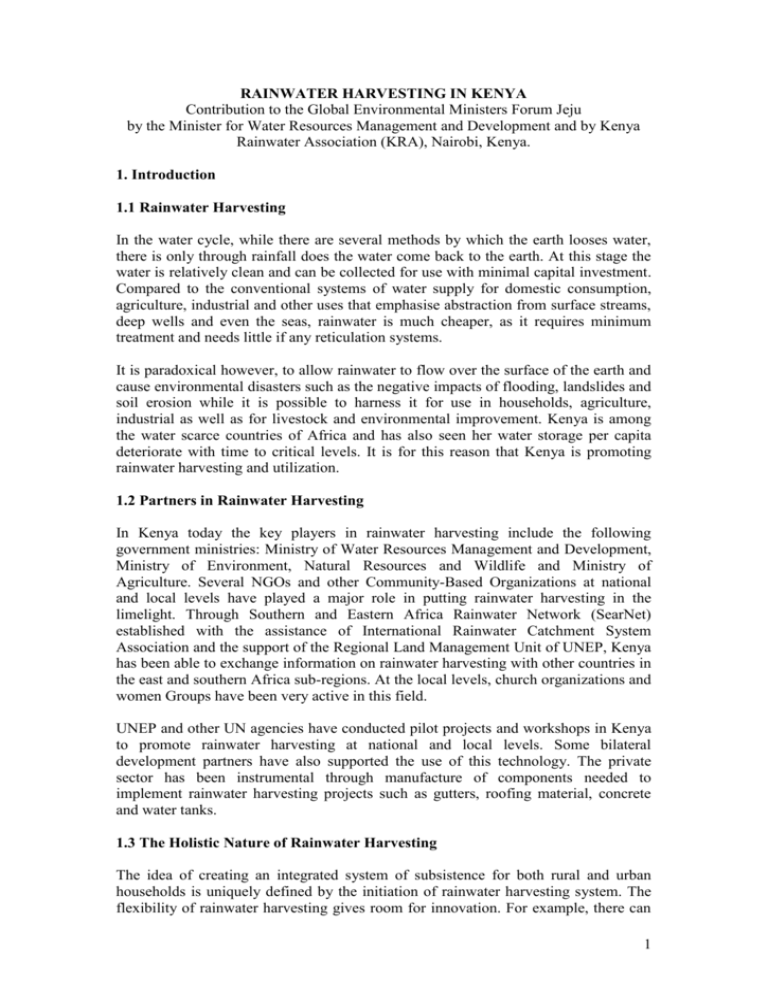
RAINWATER HARVESTING IN KENYA Contribution to the Global Environmental Ministers Forum Jeju by the Minister for Water Resources Management and Development and by Kenya Rainwater Association (KRA), Nairobi, Kenya. 1. Introduction 1.1 Rainwater Harvesting In the water cycle, while there are several methods by which the earth looses water, there is only through rainfall does the water come back to the earth. At this stage the water is relatively clean and can be collected for use with minimal capital investment. Compared to the conventional systems of water supply for domestic consumption, agriculture, industrial and other uses that emphasise abstraction from surface streams, deep wells and even the seas, rainwater is much cheaper, as it requires minimum treatment and needs little if any reticulation systems. It is paradoxical however, to allow rainwater to flow over the surface of the earth and cause environmental disasters such as the negative impacts of flooding, landslides and soil erosion while it is possible to harness it for use in households, agriculture, industrial as well as for livestock and environmental improvement. Kenya is among the water scarce countries of Africa and has also seen her water storage per capita deteriorate with time to critical levels. It is for this reason that Kenya is promoting rainwater harvesting and utilization. 1.2 Partners in Rainwater Harvesting In Kenya today the key players in rainwater harvesting include the following government ministries: Ministry of Water Resources Management and Development, Ministry of Environment, Natural Resources and Wildlife and Ministry of Agriculture. Several NGOs and other Community-Based Organizations at national and local levels have played a major role in putting rainwater harvesting in the limelight. Through Southern and Eastern Africa Rainwater Network (SearNet) established with the assistance of International Rainwater Catchment System Association and the support of the Regional Land Management Unit of UNEP, Kenya has been able to exchange information on rainwater harvesting with other countries in the east and southern Africa sub-regions. At the local levels, church organizations and women Groups have been very active in this field. UNEP and other UN agencies have conducted pilot projects and workshops in Kenya to promote rainwater harvesting at national and local levels. Some bilateral development partners have also supported the use of this technology. The private sector has been instrumental through manufacture of components needed to implement rainwater harvesting projects such as gutters, roofing material, concrete and water tanks. 1.3 The Holistic Nature of Rainwater Harvesting The idea of creating an integrated system of subsistence for both rural and urban households is uniquely defined by the initiation of rainwater harvesting system. The flexibility of rainwater harvesting gives room for innovation. For example, there can 1 arise an interrelation of variety of both economic and social activities that can improve living standards. The main idea starts from intercepting rainwater as a hydrological cycle component and diverting it to food/feed production including processing, marketing and compost sourcing/recycling. This is basically a holistic approach of interactions of many profitable activities originating from a controlled water source. From one rainwater harvesting storage structure can arise a myriad of interrelated activities including kitchen gardens, poultry keeping, zero grazing, biogas digester installations, manure harvesting, drip irrigation for horticultural crops production and fish farming among other economic activities. All these activities have a projection on increased income generation, improved nutrition status, improved sanitation and personal hygiene, creation of on-farm employment leading to poverty reduction and conservation of the environment. 1.4 How Rainwater Harvesting Addresses Environmental Issues of MDGs and WSSD Targets. According to the Global Water Partnership, ‘IWRM is an approach that ensures the coordinated development of water, land and related resources to optimise economic and social welfare without compromising on the sustainability of environmental systems’. It can be seen that rainwater harvesting fits well in this scheme. A good example can be cited of a planting pit (or Trench) used to trap rainwater in organic matter to grow Napier grass for livestock. In this case, rainwater-harvesting structure is being applied to achieve soil conservation, forestation, provision of water and nutrients to the crops and provision of additional feed for livestock. This in turn implies increased food and/or income for the farmer, and effectively addresses livelihood and poverty issues. 2.0 Mainstreaming/Sustainability of Rainwater Harvesting Kenya’s water policy takes into account all the relevant issues including water conservation and preservation of its quality. In this regard, mainstreaming of rainwater harvesting is very prominent. In agricultural production, rainwater harvesting is mainstreamed into the soil and water conservation. This approach promotes rainwater harvesting on the field thus minimising run off. Through a presidential initiative, district competitions are held to encourage farmers in water and soil conservation. Initially the emphasis was more on soil conservation but there has been a shift in thinking towards rainwater harvesting and soil conservation as equally important components. Though it is not mandatory for institutional buildings to have rainwater-harvesting facilities, many institutional government buildings especially in the rural areas, as such as hospitals and schools have installed rainwater-harvesting facilities. To make rainwater harvesting sustainable, there is need to include the initiative in the national Integrated Water Resources Management strategy. 3.0 Replicability Rainwater harvesting is not new, as communities in Kenya have practised it for a long time. Most rainwater harvesting technologies are simple, acceptable and replicable across many cultural and economic settings. There are many success stories that can 2 be cited particularly in the arid and semi-arid areas of Kenya where rainwater harvesting has been replicated. Such rainwater harvesting include Kasaye project with its agriculture component, implemented by the Kenya Rainwater Association. UNEP/Earth Care Africa project on empowering women in rainwater harvesting has a strong women and gender component. In Machakos, the project consists of harvesting water and storing it in sand and sub-surface dams. All projects have strong training components in order to build capacity of operators/artisans. The projects have been replicated directly by neighbouring communities after they realise the positive impacts of the technology, and upon field visits from the same or different communities, training workshops where rainwater has been discussed. Operation manuals and water quality guidelines have been developed for use as tools for replication. 4.0 Lessons Learnt The most important lesson learnt in the implementation of rainwater harvesting is the need to take serious consideration of environmental impact assessment before conducting any major rainwater storage project. The implication of various interventions to the entire basin must be taken into account, project be developed with the beneficial community, and community allowed time to understand and internalised new technologies for their acceptance. In all projects undertaken, it has been vital to train the community in the initial stages of the project so that at the end of the project time skills are left behind to serve community members who may be keen in adopting the technologies. 3


